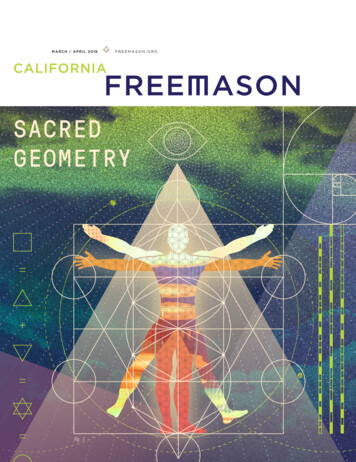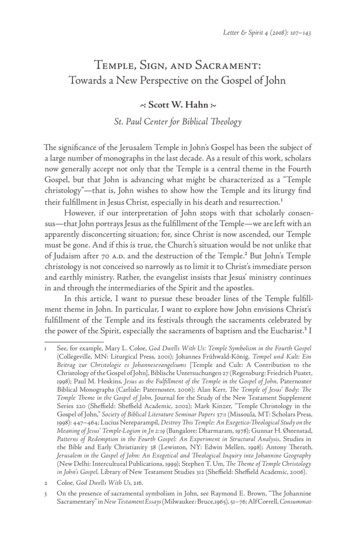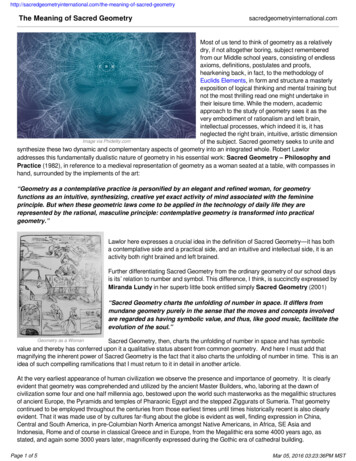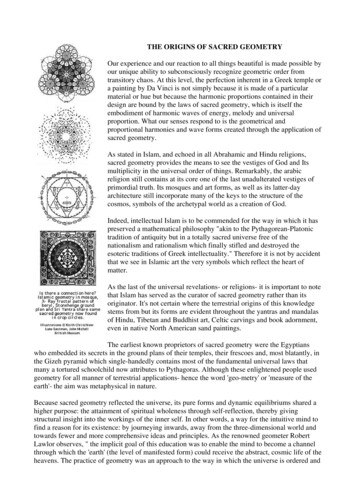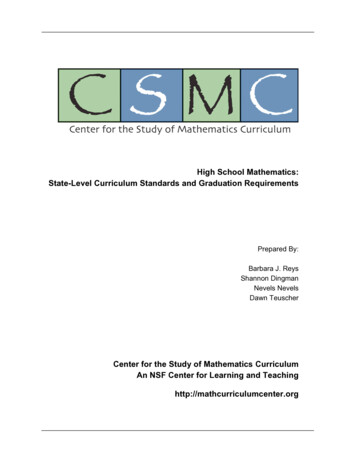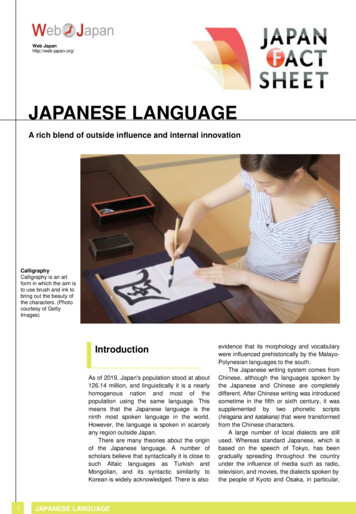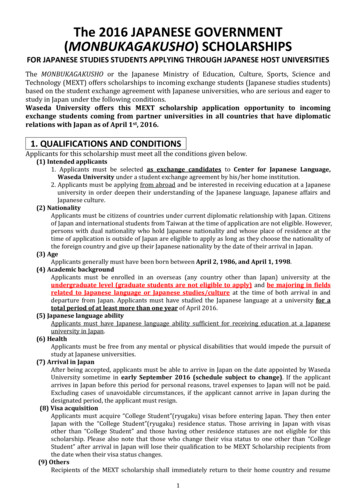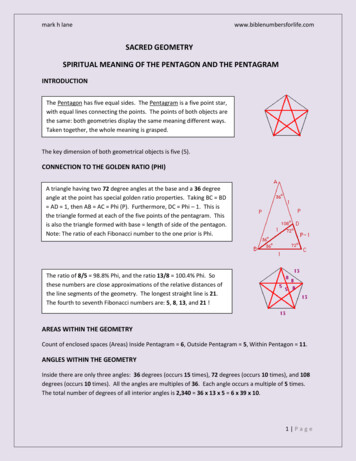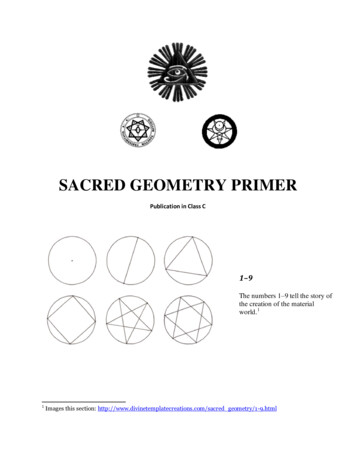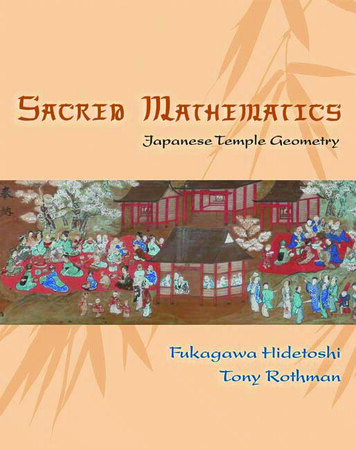
Transcription
Copyright 2008 by Princeton University PressPublished by Princeton University Press, 41 William Street,Princeton, New Jersey 08540In the United Kingdom: Princeton University Press,3 Market Place, Woodstock,Oxfordshire OX20 1SYAll Rights ReservedISBN 978- 0- 691-12745-3British Library Cata loging-in- Publication Data is availableLibrary of Congress Cataloging-in-Publication DataFukagawa, Hidetoshi, 1943–Sacred mathematics : Japanese temple geometry / FukagawaHidetoshi, Tony Rothman.p. cm.Includes bibliographical references.ISBN 978-0-691-12745-3 (alk. paper)1. Mathematics, Japanese—History. 2. Mathematics—Japan—History—Tokugawa period, 1600–1868.exercises, etc.3. Mathematics—Problems,4. Yamaguchi, Kazu, d. 1850.I. Rothman, Tony.II. Title.QA27.J3F849 2008510.952—dc222007061031This book has been composed in New BaskervillePrinted on acid-free paper. press.princeton.eduPrinted in the United States of America13579108642Frontispiece: People enjoying mathematics. From the 1826 Sanpō Binran,or Handbook of Mathematics. (Courtesy Naoi Isao.)
To the Memory of Dan PedoeWho first introduced sangaku to the worldFukagawa HidetoshiTo Freeman DysonFor long friendshipTony Rothman
ContentsForeword by Freeman DysonPreface by Fukagawa HidetoshiPreface by Tony Rothman1245678910xiiixvAcknowledgmentsxixWhat Do I Need to Know to Read This Book?xxiNotationxxvJapan and Temple Geometry1The Chinese Foundation of JapaneseMathematics3ix27Japanese Mathematics and Mathematiciansof the Edo Period59Easier Temple Geometry Problems89Harder Temple Geometry Problems145Still Harder Temple Geometry Problems191The Travel Diary of MathematicianYamaguchi Kanzan243East and West283The Mysterious Enri301Introduction to Inversion313For Further Reading337Index341
Foreword by Freeman DysonThis is a book about a special kind of geometry that was invented andwidely practiced in Japan during the centuries when Japan was isolatedfrom Western influences. Japanese geometry is a mixture of art and mathematics. The experts communicated with one another by means of sangaku,which are wooden tablets painted with geometrical figures and displayedin Shinto shrines and Buddhist temples. Each tablet states a theorem or aproblem. It is a challenge to other experts to prove the theorem or to solvethe problem. It is a work of art as well as a mathematical statement. Sangakuare perishable, and the majority of them have decayed and disappearedduring the last two centuries, but enough of them have survived to fill abook with examples of this unique Japanese blend of exact science and exquisite artistry.Each chapter of the book is full of interesting details, but for me themost novel and illuminating chapters are 1 and 7. Chapter 1 describes thehistorical development of sangaku, with emphasis on Japan’s “peculiar institution,” the samurai class who had originally been independent warriorsbut who settled down in the seventeenth century to become a local aristocracy of well- educated officials and administrators. It was the samurai classthat supplied mathematicians to create the sangaku and work out the problems. It is remarkable that sangaku are found in all parts of Japan, includingremote places far away from cities. The reason for this is that samurai werespread out all over the country and maintained good communications evenwith remote regions. Samurai ran schools in which their children becameliterate and learned mathematics. Samurai combined the roles which inmedieval Europe were played separately by monks and feudal lords. Theywere scholars and teachers as well as administrators.Chapter 7 is my favorite chapter, the crown jewel of the book. It containsextracts from the travel diary of Yamaguchi Kanzan, a mathematician whomade six long journeys through Japan between 1817 and 1828, recordingdetails of the sangaku and their creators that he found on his travels. The
xForeword by Dysondiary has never been published, but the manuscript is preserved in the archives of the city of Agano. The manuscript runs to seven hundred pages,so that the brief extracts published here give us only a taste of it. It isunique as a first-hand eye-witness description of the sangaku world, writtenwhile that world was still at the height of its flowering, long before the sudden irruption of Western culture and modernization that brought it to anend. I hope that the diary will one day be translated and published in full.Meanwhile, this book, and chapter 7 in particular, gives us a glimpse ofYamaguchi Kanzan as a mathematician and as a human being. Havingbeen present at the creation, he brings the dead bones of sangaku to life.I am lucky to have known two scholars who have devoted their lives tocultivating and teaching geometry. They are Daniel Pedoe in England andthe United States, and Fukagawa Hidetoshi in Japan. Each of them had toswim against the tide of fashion. For the last fifty years, both in art andmathematics, the fashionable style has been abstract: famous artists such asJackson Pollock produce abstract patterns of paint on canvas; famous mathematicians such as Kurt Gödel construct abstract patterns of ideas detachedfrom anything we can feel or touch. Geometry is like representationalpainting, concerned with concrete objects that have unique properties andexist in the real world. Fashionable artists despise representational painting, and fashionable mathematicians despise geometry. Representationalpainting and geometry are left for amateurs and eccentric enthusiasts topursue. Pedoe and Fukagawa are two of the eccentric enthusiasts. Both ofthem fell in love with sangaku.Fukagawa Hidetoshi has been a high-school teacher in Aichi, Japan, formost of his life. During school holidays he has spent his time visiting temples all over Japan, photographing sangaku as works of art and understanding their meaning as mathematical problems. He knows more about sangakuthan anyone else in the world. Unfortunately, in the hierarchical academicsystem of Japan, a high-school teacher has a low rank and is not highly respected. He was not able to interest high-ranking professors in his proposalto publish a book about his findings; without support from the academicestablishment, his work remained unpublished and unknown. After manyyears he finally found a publisher outside Japan, with the help of DanielPedoe.Daniel Pedoe was my teacher when I was studying mathematics as a boy inan English high-school long ago. He gave me my first taste of mathematicalresearch, asking me to work out a mapping of the circles in a Euclidean planeonto the points of a three-dimensional Euclidean space. I found the mapping,
Foreword by Dysonand my eyes were opened to the power and beauty of geometry. Many of theproperties of circles became intuitively obvious when I looked at the map.Later, I renewed my friendship with Pedoe after we both moved to America.Forty years later, Pedoe discovered sangaku. He was then a professor of mathematics in Minnesota, and there he received a letter from Fukagawa. Fukagawa had written to six mathematicians known to be interested ingeometry, informing them of the existence of sangaku and inviting them tocollaborate in making sangaku known to the world outside Japan. Pedoe wasthe only one of the six who answered. He agreed to collaborate with Fukagawa in producing the book Japanese Temple Geometry Problems, which waspublished in English in 1989 by the Babbage Institute in Winnipeg, Canada.Pedoe paid for Fukagawa and his wife to come to Minnesota to work on thebook, and he also visited Fukagawa in Japan. He remained a close friend ofFukagawa’s and a promoter of sangaku until his death in 1998.In 1993 I was invited to Japan to give lectures at Japanese universities,and I finally had a chance to meet Fukagawa in person. Dan Pedoe madethe arrangements for our meeting. My academic hosts expressed surprisethat I should wish to speak with a “lowly” high- school teacher, and tried tocut my visit with him short. They allowed me only a few hours to spend withhim, visiting a temple where some outstanding sangaku are preserved andan abacus museum where we could see other artifacts of indigenous Japanese mathematics. I would happily have stayed longer, but my hosts wereinflexible. Since then I have stayed in touch with Fukagawa as he continuedto make new discoveries and deepen his understanding of the historicalcontext out of which the sangaku emerged.This book contains far more than the book that was published in Winnipeg in 1989, which presented the sangaku as a gallery of isolated works ofart, without any information about their historical context. Little or nothing was said about the artists who created them or the connoisseurs forwhom they were made. This book supplies the missing background information. One third of the book (chapters 1, 2, 3, and 7) is a narrative history of Japanese mathematics, with a full account of the leading individualmathematicians and the society to which they belonged. The middle section (chapters 4, 5, and 6) is an up-to- date display of sangaku problemsarranged in increasing order of difficulty. The final section (chapters 8, 9,and 10) is a technical discussion of Japanese mathematical methods, with acomparison of Japanese and Western ways of solving geometrical problems.In conclusion, I wish to thank my friend Tony Rothman for his big sharein the writing of this book. I am responsible for introducing him to templexi
xiiForeword by Dysongeometry, and grateful to him for the long months of hard work that he putinto the project. Although Fukagawa was the prime mover, it was Rothmanwho brought the task to a successful conclusion. Rothman translated andparaphrased Fukagawa’s notes into readable English, and contributedmany explanatory passages to make the mathematical problems and solutions understandable for English- speaking readers. Those familiar withRothman’s writing will recognize his work throughout. Without Rothman’smassive and unselfish help, the book could never have been published.Institute for Advanced Study,Princeton, New Jersey
Preface by Fukagawa HidetoshiWhen I became a high school mathematics teacher forty years ago,I studied the history of Western mathematics and would present some ofthis historical material to my students. In those days, it was said that traditional Japanese mathematics had no material of any value for high schoolstudents. In 1969, a teacher of traditional Japanese literature showed me atraditional Japanese mathematics book printed in 1815 from wooden blocks.He asked me to decipher the book since it was written in difficult old Japanese. When I finished deciphering it, I found that traditional Japanesemathematics of the seventeenth, eighteenth, and nineteenth centuries hadmuch good material for high school students. In those centuries Japanclosed its doors to the outer world and many native cultures developed, oneof which was traditional Japanese mathematics. In Japan in that era, therewas no official academia, so mathematics was developed not only by scholars but also by ordinary people. Lovers of mathematics dedicated to shrinesand temples the wooden tablets on which mathematics problems were written. We call this mathematical world “Japanese temple geometry.” Themathematics lovers who formed this world enjoyed solving geometry problems. The present authors hope that readers of this book will also find enjoyment in trying to solve some of those same problems.
Preface by Tony RothmanI vividly remember the day if not the year: It was 1989 or 1990; I hadstopped by Freeman Dyson’s office for lunch at the Institute for AdvancedStudy in Princeton, New Jersey. No sooner had Freeman raised his hand inhis customary salute than he said, “Take a look at this,” and placed into myown hand a small paperback book he’d received that very morning. Thesimple blue cover bore the title Japanese Temple Geometry Problems, San Gaku,and nothing more. The words meant nothing to me, and the blank expression on my face surely conveyed as much to Freeman. Paging through thebook, I saw that it was a collection of geometry problems, assembled by Hidetoshi Fukagawa and Freeman’s old math teacher from England, Dan Pedoe, who had sent it to him. Over the next few minutes, Freeman began tochuckle and then guffaw as he watched my expression change from bafflement to disbelief to open astonishment. For good reason. The first thingthat struck me about the problems was how different they were from thethose I’d studied in high school geometry. Nothing like this was ever produced in the West. The problems looked Japanese. The second thing thatstruck me was how beautiful they were, no less than miniature Japaneseworks of art. The third thing that dawned on me in those confused moments was how difficult they were. Without having attempted a single oneof them, I understood quickly enough, standing there with dropped jaw,that I hadn’t the faintest idea of how to tackle the majority—and I am supposed to be a mathematically inclined physicist.Through Freeman I had stumbled on the strange and wonderful tradition of Japanese temple geometry. As readers will learn in the comingpages, for over two hundred years Japan was isolated by imperial decreefrom the West and had little, if any, access to Western developments inmathematics. Yet during that time Japanese mathematicians from all walksof life created and solved astonishingly difficult problems, painted the solutions on beautiful wooden tablets called sangaku, and hung the tablets inBuddhist temples and Shinto shrines.
xviPreface by RothmanStruck by this unique custom, I eventually wrote to Hidetoshi Fukagawa,the Japanese author of the problem book, and asked whether there wasenough known about sangaku to warrant an article for Scientific American.Fukagawa, a high school teacher in Aichi prefecture with a doctorate inmathematics, replied that probably enough was known about the custom’sorigin for an article, and he generously supplied time and material. As itturned out, Hidetoshi was one of the world’s experts on Japanese templegeometry, or more generally traditional Japanese mathematics. He himself had stumbled on a mention of sangaku in an old book decades earlier,decided they were an excellent teaching tool, and had been studying themever since. Hoping to interest Westerners in the tradition, he’d written randomly to a number of Eu ropean and American mathematicians. DanPedoe, a noted educator, alone responded and the result was the book thatFreeman had received. And so, with substantial help from Hidetoshi, Iwrote a piece for Scientific American, which after languishing in editoriallimbo for three or four years, eventually appeared in the May 1998 issue.The present book is partially an outgrowth of the Scientific American article and Hidetoshi’s earlier work. However, we did not want to publishmerely another problem book. Rather, we decided to try to place the problems in the context of traditional Japanese mathematics and, more generally, of the culture of the times. To set the stage, we have given a shortintroduction to Japanese mathematics, especially in the seventeenth century, when the tradition of temple geometry began, and we have also included a chapter on traditional Chinese mathematics, which so profoundlyinfluenced Japanese developments. Throughout, we have attempted tomaintain an historical flavor, including discussions of the important Japanese mathematicians and, along with the problems, vignettes about thecreation and discovery of the tablets on which they are found.Since the appearance of the Scientific American article, moreover, Hidetoshi and his colleagues have learned a great deal about the origins oftraditional Japanese mathematics, and we are able to present significantlymore material about the origin and purpose of sangaku. In particular, weare pleased to bring to a Western audience for the first time a substantialexcerpt from the travel diary of Yamaguchi Kanzan, an early nineteenthcentury mathematician who took several extended walking tours aroundJapan specifically to collect sangaku problems. Yamaguchi’s diary provides a“smoking gun” showing that Japanese mathematicians often hung the tablets
Preface by Rothmanas acts of worship, thanks to the gods for being able to solve a difficult problem. In this sense, temple geometry is indeed sacred mathematics.Finally, in the years since the article appeared, Hidetoshi has succeededin organizing a large exhibit of over 100 sangaku at the Nagoya Science Museum, which took place in 2005 under sponsorship of the daily newspaperAsahi Shinbun. We are fortunate to be able to publish here some of the original photographs from the exhibit catalog. Readers cannot but be struck bythe beauty of the tablets and we are certain it will add to the artistic aspectof the book. To that end, we have attempted to include contemporary drawings and illustrations that will put the mathematical art in the context of theprevailing art of the times. We have also included some of the original drawings of temple geometry problems from rare seventeenth-nineteenth century rice-paper books. We hope that they help make Sacred Mathematics asmuch an artistic creation as an historical and mathematical one.The authors’ collaboration for this project has been unusual. To this dayHidetoshi and I have never met and the work has taken place entirely byemail. Hidetoshi has been the primary author. His collection of rare bookson traditional Japanese mathematics, consisting of several hundred volumes,dwarfs anything available in Western libraries, and by now he has been studying the subject for forty years. My role has been to a large degree editorial.Hidetoshi’s native language is far from English, and I speak no Japanese.Fortunately, mathematics is universal. I have taken Hidetoshi’s drafts and attempted to render them in reasonably fluent English. I have also added substantial material, redrawn the diagrams, and gone through all the proofs,attempting to simplify them slightly. Hidetoshi’s solutions are those of a professional mathematician, and I have frequently felt a few more steps and diagrams were needed to make them accessible to American students (or atleast their teachers!), who we certainly hope will try the problems. In themore difficult exercises I have added more explanation, in the easier onesless, sometimes none at all; one or two of the solutions are my own.My only guide in this procedure has been my experience of having taughtmany university students, often freshmen, from whom I have learned that ifI have difficulty with a problem, they sometimes will. In Sacred Mathematicswe often present traditional solutions. However, these are frequently translations from Kanbun to Japanese to English with modern mathematical notation, whereas traditional solutions did not use trigonometric functions,lacked indications of angles, and so forth. The “traditional” proofs in thisxvii
xviiiPreface by Rothmanbook therefore should not be regarded in any sense as literal transcriptions.When we have been able to closely follow the original, I have put my comments in brackets []; otherwise, I have edited the traditional proofs as I haveall the others. Whether I have found a reasonable balance in all this, theaudience will judge. I am certain only that professional mathematicians willbe annoyed, but I hope they will indulge the lack of formality.An ideal second author for this book would have been a mathematicianfluent in Japanese as well as in Japanese history. The present circumstanceis not perfect, especially in the case of Yamaguchi’s diary, because I have noway of knowing how accurate my translation has been, except insofar as ithas met with Hidetoshi’s approval. But, as they say, I wanted to get the jobdone, and will welcome a better translation in the future by a professional.Among the hurdles in learning Oriental mathematics is the bewilderingprofusion of transliterations and translations for Chinese names and booktitles, some almost unrecognizable as referring to the same person or work.For the Chinese I have usually gone with the transliterations from the St.Andrews University MacTutor website, merely on the assumption that mostreaders will follow up there on any statements made here. Japanese namespresent their own problem. In Japan, it is customary to refer to people bysurname first. Not only that, but Japanese mathematicians often have twonames, one used by Westerners and one used by Japanese. In this book wefollow the convention of surname first, and also use the names most common among Japanese. Thus the most famous Japanese mathematician,known as Kowa Seki in the West, becomes Seki Takakazu and Hidetoshi Fukagawa becomes Fukagawa Hidetoshi. After considerable discussion we havedecided to use the Hepburn romanization system for the transliteration ofJapanese words, which is not popular among the Japanese but is the mostfamiliar to Western readers. We might also mention that we have, as consistently as possible, spoken of Buddhist temples but Shinto shrines.Finally, despite all vigilance, errors must inevitably creep into a booksuch as this. Readers should report any such discoveries to the publisher orauthors.
AcknowledgmentsFukagawa Hidetoshi would like to thank many friends and colleagueswho supplied illustrations, books, access to sangaku and assistance whilepreparing Sacred Mathematics. They include Abe Haruki, Endo Shinosuke,Hori Yoji, Ito Akira, John Rigby, Matsuzaki Toshio, Naoi Isao, NishiyamaHiroyuki, Nomura Tatsumi, Oyama Shigeo, Peter Wong, Fujii Sadao, Sasaki Eiji, and Taniguchi Takeshi. Most of all he thanks his wife FukagawaMiyoko for her patience with his lifelong hobby.The authors are also grateful to the Asahi Shinbun company for sponsoring the 2005 sangaku exhibit in Nagoya and making available images fromthe exhibit catalog for this book. We thank as well the numerous institutionswho supplied material and illustrations. They are Agano City Board of Education, the Aichi University of Education Library, the Hiroshige Art Museumof Nakasendou, the Imizu city Shinminato Museum, the Japan Academy, theMaeda Ikutokukai Institute, the Nagasaki Museum of History and Culture,Nagoya Broadcast Network Co., Ltd., the Sekigahara Museum of History andCulture, the Tsurumai Central Library City of Nagoya, and Tamura CityBoard of Education.This book would not have been possible without the cooperation of themany shrines and temples that permitted access to their sangaku, allowedthem to be photographed, and to be placed on display. The authors are grateful to the Abe no Monjuin temple in Fukushima prefecture, the Atsuta shrinein Aichi prefecture, the Dewasanzan shrine in Yamagata prefecture, the Isobeshrine in Fukui prefecture, the Katayamahiko shrine in Okayama prefecture,the Kitamuki Kannon temple in Nagano prefecture, the Meiseirinji temple inGifu prefecture, the Mizuho shrine in Nagano prefecture, the Shimizu shrinein Nagano prefecture, the Souzume shrine in Okayama prefecture, the Sugawara shrine in Mie prefecture, the Todaiji temple, and the Ubara shrine.Tony Rothman would like to thank John Delaney of the Historic MapsCollection at Princeton University for supplying rare maps of Japan, the staffat Princeton University Press for their willingness to take on a complex project, Yasuko Makino for help with the transliterations, and Marvin Suomi forgenerous support.
What Do I Need to Know to Read This Book?We hope this book can be read in three ways: as an art book that delights simply by the perusal of it, as a history book that provides a little insight into an aspect of Japanese culture rarely mentioned in standardsurveys, and finally as a problem book that provides challenging exercisesat both the high school and college levels.Readers who intend to tackle the problems may wish to know at the outset the prerequisites. One requirement looms above all: patience. On firstencounter with a sangaku problem there is a considerable “choke” factor. Atfirst glance, Western students will find many of the problems strange, unlike those they have seen before, and one’s first reaction tends to be, “Ican’t do that!”Do not despair! Half the problems in Sacred Mathematics require no morethan the most elementary methods, taught in any high school geometrycourse. The individual steps are no larger than in typical textbook problems. What is different is that sangaku problems are frequently far more intricate than the usual exercises American students encounter. Instead ofrunning four or five lines, proofs may run four or five pages—if not ten.What is more, it is necessary to bring to bear everything you’ve learned fromyour geometry course. Sooner or later you will require virtually every theorem about circles, quadrilaterals, triangles, and tangents that you haveproved. Some of the more difficult exercises require a good deal more thanthat. You should not be surprised if you spend hours—or days—workingthe advanced problems.Following patience, a number of specific tools are required to solve sangaku problems. Because Sacred Mathematics is not intended to be a textbook,however, for the most part we do not teach basic methods. If you do try theproblems it is a good idea to have a standard geometry text handy as a reference. A few suggestions, ranging from the elementary to the advanced areoffered in “For Further Reading” on page 337; nevertheless, by way of helpful hints we can be a bit more specific here about what you will need.
xxiiWhat to Know to Read This BookA good drawing is indispensable. Many of the problems are fairly subtle,and it is not enough to make a rough sketch, which will deceive you; youneed to make an accurate drawing that reflects the true conditions of theproblem. Often the route to a solution becomes obvious when you’ve drawnin the appropriate auxiliary lines.The single most important mathematical tool will be the Pythagoreantheorem. This basic theorem, which was known to the Japanese throughChina, is used constantly throughout, and a large percentage of the problems can be solved with nothing more. If you are uncomfortable with thePythagorean theorem, the problems in this book will be extremely difficult.Hand in hand with the Pythagorean theorem, many, if not most, of theproblems require solving quadratic equations. Not only will you frequentlyneed the quadratic formula, which was also known to the Japanese, but itwill often prove more convenient to solve the equation by “completing thesquare.” Nearly as often you will encounter quadratics in the square root ofa quantity, usually the radius of a circle, r , and so you will need to knowthe basic methods for handling square roots, such as rationalizing denominators.After the Pythagorean theorem and quadratics, the most frequentlyneeded tool is probably properties of similar triangles, those theorems thatgo by names like AAA and SAS. You need all of them. Likewise, you willrequire virtually all the trigonometric identities involving sine, cosine, andtangent, that is, not only the basic Pythagorean identity, sin2 θ cos2 θ 1but every variation on it, as well as all the half-angle and double-angle formulas.The law of cosines also crops up often. This is the generalization of thePythagorean theorem for nonright triangles that gives the third side of atriangle c in terms of the other two sides: c 2 a 2 b 2 2ab cos θ , where θ isthe included angle between sides a and b. The law of sines also figures occasionally: a/ sin A b/sin B c/sin C, for triangles with vertex angles A, B,C and opposite sides a, b, c. Although traditional Japanese mathematiciansdid not explicitly use trigonometric functions, they did employ the equivalents and all these relationships were understood by them. Solutions toproblems in chapters 4 and 5 will give a better idea of how those mathematicians operated.Frequently, problems are solved by considering the area of triangles,rather than the lengths of the sides. In both this context and when employing the Pythagorean theorem, one basic fact crops up repeatedly: that two
What to Know to Read This Booktangent segments to a circle drawn from an external point P are equal inlength. This is sometimes referred to as the “tangent segments theorem.” Ifyou have not seen this proven in an elementary course, you may wish toprove it now; it is very easy. The “intersecting chords theorem” is also frequently encountered: if two chords intersect in a circle, the product of thelengths of the segments of one chord equal the product of the lengths ofthe segments of the other chord (figure 0.1). Other theorems we introduceas needed.cbadFigure 0.1. The intersecting chords theorem: a b c dFor solving some of the more advanced problems, a “modern” techniquethat proves extremely useful is that of “inversion.” However, because inversion is not generally taught in schools anymore, we include a chapter (10) toexplain this powerful method.A handful of problems requires calculus, but except for a very smallnumber, this does not go beyond basic differentiation and integration.xxiii
NotationWe have tried to keep the notation used throughout this book standardand simple, but, at the risk of annoying professionals, have also tried to obviate some terms that nonmathematicians may not regularly encounter, suchas “circumcircle” and “perpendicular foot.” (Clearly, feudal Japanese farmers would not have used such terminology.) When avoidance of specializedterms has proven futile, if we do not define them explicitly, we trust they aredefined in context. For the record, “circumcircle” is merely the circle circumscribed around a given polygon, while “incircle” is the circle inscribedwithin a given polygon. “Circumcenter” and “incenter” refer to the centersof these circles. When many figures are contained in, for example, a circleand touch one another, we sometimes speak of the colle
his is a book about a special kind of geometry that was invented and widely practiced in Japan during the centuries when Japan was isolated . The present authors hope that readers of this book will also fi nd en-. Sacred Mathematics Sacred
